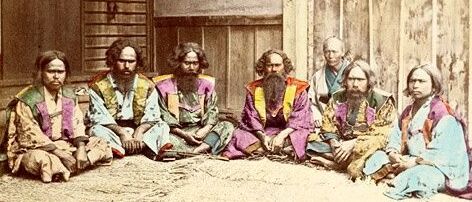
Seated group of Ainu men.
I think the OP should read my break down of “race” as it relates to modern genetic science: Collin Anthony Spears’ answer to How many human races are in the world?
In any case I am willing to say they are an East Asian people…clearly, although a bit genetically divergent from other populations in the region.
The remnant of the indigenous Japanese population, the Ainu, are thought to be descendants of the first civilization on Japan, the Jomon, and are a cultural isolate…they are closely related to no existing group in East Asia.
!!!Update below!!!
The Ainu are descendants of the Jomon people. They are genetically distinct and not closely related to other groups, but show some connections to East Asians especially to Siberians, some northeastern Asians and some native Taiwanese.
Some scientists suggest that the Ainu/Jomon are descedants of ancient Siberians that are mostly extinct today. Some native Americans on the Northwestern coast have many similarities to the Ainu people in Japan. Others suggested an origin in Southeast Asia. Modern studies suggest a heterogene origin and multiple migrations during and before the Jomon period.
The race of the Jomon people is hard to classify. Some suggest possibly Mongoloid (proto-Mongoloid). Others suggest Caucasoid or an ancient extinct Siberian race. Recently it was found that the Jomon people were not a homogenous population, but a mix of (at least) two distinct groups. Mongoloid and Caucasoid traits were present. while Mongoloid, specifically proto-Mongoloid, traits formed the majority, a Caucasoid substratum was influential.
The descendants of the Jomon, the Ainu look on the one hand similar to European people but on the other also somewhat similar to some Native Americans and Native Taiwanese.
Here are some modern Ainu:
Phenotypically somewhat similar to Central Asians (mixed Asian/Europeans) or?.
!!!UPDATE!!!
According to recent studies, the Jomon people are possibly not one homogenous group, but were two or three groups.
It was previously thought that the main y-DNA of Jomon is y-DNA D. But recent studies confirmed that the haplogroup y-DNA C1a1 is also a Jomon marker.
Actually, the y-DNA D was the first on the Japanese islands, some 30,000 years ago. But then a second wave, some 13,000 years ago pushed into Japan. This was the C1a1 group. The Jomon period started soon after this second migration. Thus many believe now that this second group was not a hunter-gatherer but a more war-like or agricultural people. C1a1 is only found in some Jomon remants, modern Japanese (5–15%) and Paleolithic and Neolithic Europeans and North-Eurasians.
(Map showing the migration roots of D-carriers and C-carriers.)
There are several studies that suggest that a Caucasoid group migrated into Japan (Carriers of C1a1 also known as C-M8).
According to Japanese studies, one population (carriers of paternal haplogroup C1a1) migrated about 13,000 years ago into Japan, likely from West Asia through Siberia into Japan. There they interacted with a population (carriers of D1b) that were already present in Japan.
The haplogroup C1a1 is only found in Japan at 5%–15%. The next relative of C1a1 is C1a2 which was common in ancient European and West Asian samples and today in some Europeans, Arabs and Armenians. According to Mitsuru Sakitani these carriers of C1a1 likely belonged to a Caucasoid related group.
So modern Japanese are predominantly Mongoloid but some have a more “mixed” look. Likely because of these ancient groups of people.
The average distribution of C1a:
Interestingly a recent full genome analysis of a 3,800 year old Jomon person found ~14% European/West Asian related ancestry and ~86% East Asian related ancestry.
Most anthropologists classify the modern Ainu as a Eurasian population. That means they are mixed today.
The ancestors of the Ainu, the Jōmon people belonged to a Caucasoid branch. Recent genetic and anthropologic studies suggest that an ancient Caucasoid population migrated to Japan and some other parts of Northeastern Asia. There they mixed with various Mongoloid groups forming the ancient Ainu, Emishi and other Jōmon related tribes. Later Mongoloid Yayoi migrated into Japan and conquered the land. These Yayoi displaced the Jōmon largely but mixing occurred as well.
Many anthropologists classify the Ainu as a Caucasoid population. A more recent study suggests that the original Ainu were of Caucasoid origin but mixed early with surrounding Mongoloid tribes. They suggest that the Ainu can especially be linked to Paleolithic Europeans (not today’s Indo-Europeans but the pre-Indo-Europeans). Cranial data of Ainu suggests that they can be linked to northern West-Eurasian (=European) populations. DNA analyses show that the Ainu can digest alcohol and high fat, they exhibit wet ear wax and their immunoglobulin is similar to European and Middle Eastern ones. All these characteristics differ strongly from Japanese or other East Asians and Southeast Asians.
Some other scientists also note a possible connection to the Ancient North Eurasians, a Caucasoid population that contributed about 30% of their genome to Native Americans.
What race are the Ainu people of Japan? They are a Eurasian population, a mix of Caucasoids and Mongoloids.
Additional Material of interest!
 (Sean Connery? No…! An Ainu Man – Ainu are the aboriginal “lost Caucasian race” people of Hokkaido, Japan’s most northern island.)
(Sean Connery? No…! An Ainu Man – Ainu are the aboriginal “lost Caucasian race” people of Hokkaido, Japan’s most northern island.)
(see: noriohayakawa.wordpress.com/2017/11/10/the-untold-story-of-japans-first-people-the-ainu/)

[Editor’s Note: The connections between the Haida and Tlingit and the Ainu of Hokaido, Japan, can not be over-stated.]
The traditional clothing is remarkably similar, and even the existence of “carved and sculpted poles…” – hubpages.com
The Ainu constructed a type of totem pole in the north of Japan. Northern Asians are linked to North American Natives. – HubPages.Com

(Ainu totem pole)
–
(For the source of this, and many other equally interesting articles, please visit: http://www.bbc.com/travel/story/20170202-a-surprising-way-of-showing-gratitude/)








